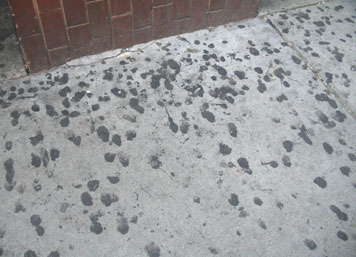
Near Union Square on Fourteenth Street, photograph by Nicolas Heller.
During the Beatles' first U.S. tour in 1964, John Lennon marveled at how New York's sidewalks were paved with diamonds. He was referring, of course, to sparkling glassphalt — asphalt mixed with crushed glass routinely used to fortify the concrete. But I wonder whether he also saw the so-called street measles, those ugly black blotches that have long marred urban pavements. Actually, I've been seeing a lot more of them lately and if you live in any city (and look down to avoid eye contact as I do) you must have seen them too. But if you don't know what they are you might be surprised to learn that each splotch is a piece of chewed gum brazenly spit from pedestrians' mouths, then ground by hundreds of walking feet into black grout that forms into hardened viscous globs. To me this suggests that gum chewers are possibly filthier than cigarette smokers, whose butts, at least, can be easily swept up. Conversely, caked amebic gum spatter is extremely time consuming and costly to remove using "gum-busting" steam-cleaning machines. Yet my aim in this essay is not to raise mass consciousness about gum pollution.
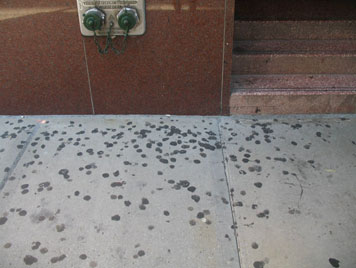
Medical Building on Sixteenth Street between Fifth Avenue and Union Square West, photograph by Nicolas Heller.
Although discharging wads of goop on public walkways is truly disgusting (would you do this in your own home?) and arguably more dangerous than throwing banana peels on the sidewalk, I cannot support, as some have suggested, a ban on public gum chewing and its dubious disposal. Actually there are already ordinances on some municipal books from the days when chewing tobacco was in vogue that prohibits such wanton spitting, but enforcement is difficult at best. "Gum has been a problem since the beginning of time," proclaimed Mayor Joseph Vas, Mayor of Perth Amboy, New Jersey, about a splotch outbreak in his city. Now that the major gum producers have introduced upscale gum products — like Orbit, Eclipse, Carefree (though I've always been partial to Black Jack) — which has increased overall gum sales and advanced chewing over the past couple of years, the amount of splotches have exponentially increased (at least according to my unscientific survey), and in New York City the problem has consequently spread to almost every neighborhood.
Given its epidemic proportions, last year I decided to take a closer look at gum splat as a kind of social and visual phenomenon — a veritable vernacular street "language" — that speaks to certain behavioral patterns of city life. Over the past year, I've been something of a gumshoe, investigating and documenting these patterns, visiting devastated areas and talking to perpetrators and victims alike. Now I'm ready to share my findings.
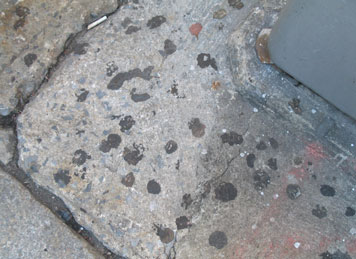
Corner of Union Square and 15th Street, photograph by Nicolas Heller.
Just so you know, chewing gum has existed since the ancient Greeks chewed a substance made from the resin of a mastic tree. Subsequent gums were made from the sap of spruce trees as well as paraffin wax. Modern gum was extracted from Mexican chicle (remember Chiclets brand, I always wondered where the name came from); originally it used as a rubber substitute but was found to work better in a chewable form. Most gum companies currently use synthetics, although some still rely on natural glutamates. There are scores of different gum genres — bubble, medicated, breath-freshner, laxative, and more — and gum display shelves in candy stores and delis are filled with well over a score of different high- and low-end brands. Gum chewing is used to relieve stress, freshen the mouth, even clean teeth; its used to ease pressure when flying and even has certain cool panache — both macho and sensual. The likes of artists and musicians, but also police, firemen and plumbers seem to be frenetic chewers. Then, of course, kids are chewing machines (although most schools prohibit chewing in class, the bottoms of school desks are testament to how effective such rules really are).
Speaking of kids, my survey (which covered a geographical area between 23rd and Houston Streets in Manhattan) reveals that the largest concentration of gum goop is usually right outside public school entrances. It was in front of New York's "School for the Future" High School where I found a virtual Jackson Pollack of cement canvases filled with splotches so dense it could easily be compared to an Ad Reinhart — it is so black that the sidewalk is barely visible. The most intense of this particular splattering is located within five feet to the right or left of the entrance, which suggests that the students either dispose of their gum immediately before entering or after leaving (if the latter is true then they've been chewing for hours). I also checked the entrances to nearby Simon Baruch Junior High, P.S. 40, Washington Irving High, and a bit further away at Asher Levy Middle School, and the proportion of goop to sidewalk was also much denser than at other locales. Surprisingly, this was not true at private schools located in the same general radius. Friends Seminary, Immaculate Conception, Little Red School House and Elisabeth Irwin High School all had less gum buildup. To determine why this was true, I loitered outside of a few of these schools for a few hours at a time recording students' habits. Those in the public schools did indeed spit more than private school students. When I asked a few kids for rationales, I was told to mind my own business. I had to find another way. So I decided to focus on "adult" areas.
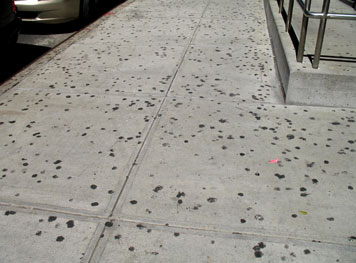
Entrance of "School of the Future," 22nd Street and Irving Place, photograph by Nicolas Heller.
Lower Fifth Avenue has a high occurrence of gum stains: not as bad as the infestation around schools but enough to raise eyebrows. In the five blocks either to the north or south of the AIGA national headquarters on 21st Street and Fifth Avenue, the density was much greater than around nearby Madison Square Park. These admittedly random patterns of splotches also seem also to be better designed in front of AIGA than elsewhere in the vicinity, but this could just be my imagination. The fundamental reason for this "distinct occurrence pattern" (a term I apply to formations of goop) is that Fifth Avenue is a highly congested street during weekdays, with many offices housing music, fashion, design and other creative industries — all full of potentially very-stressed gum chewers — so in addition to stains in front of building entrances, it's possible to trace a gum line from office buildings to various popular lunchtime eateries, with fast-food delis having the largest concentration of stains outside their doors. Madison Park is where people go to eat lunch or sit calmly watching birds, which reduces the need to nervously chew. In addition, on the weekends Fifth Avenue gets a large "tunnel" crowd from New Jersey, which for reasons best left vague, have the highest sidewalk gum-spitting ratio in the region. After nailing why Fifth was the way it was, I moved east.
Over the past decade Union Square has been strikingly transformed — the park is beautiful and the five-day-a-week farmer's market has raised the energy level of the entire area. In addition to New York's usual park denizens, it is Mecca for many young professionals and hip Eurotrash, and, because of this demographic, gum goop prevails at least on the perimeter of the park, while inside there is limited coverage because of what appears to be a rapid cleanup force, made up, oddly enough, by gum chewers. Conversely the sidewalks where skateboarders hang-ten and itinerant musicians place their hats is fairly dense with goop. It also appears that the average customer for the Virgin Mega Store and Circuit City, which faces the park, does a good share of the area's daily chewing (I speculate five sticks of Winterfresh every two hours, if my 18-year old son is an indication).
After time well spent in Union Square, I was ready to head uptown to the more swanky New York neighborhoods — Turtle Bay, Murray Hill and Sutton Place — where splotches were noticeable but in considerably lesser quantities. What was on the ground was put there, apparently, not by residents but interlopers. Since these neighborhoods do not have a lot of retail traffic the volume of interloping is keep to a minimum, in fact, I was looked upon with suspicion. So when I asked a randomly selected Murray Hill pedestrian why he thought there was so little gum goop in the neighborhood, I was told to mind my own business. Maybe I should not have been chewing when I spoke.
In any case, my exhaustive survey turned up the following results: Gum splatter is disgusting. Kids who have no respect for their environment do it to excess. Adults who work in stressful industries chew too much and potentially spit it on the sidewalk, unless they live on Sutton Place. John Lennon chewed a lot of gum, but to my knowledge he never spit a wad on a New York City street.
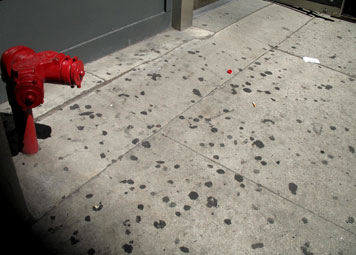
Fifth Avenue and 19th Street, photograph by Nicolas Heller.
